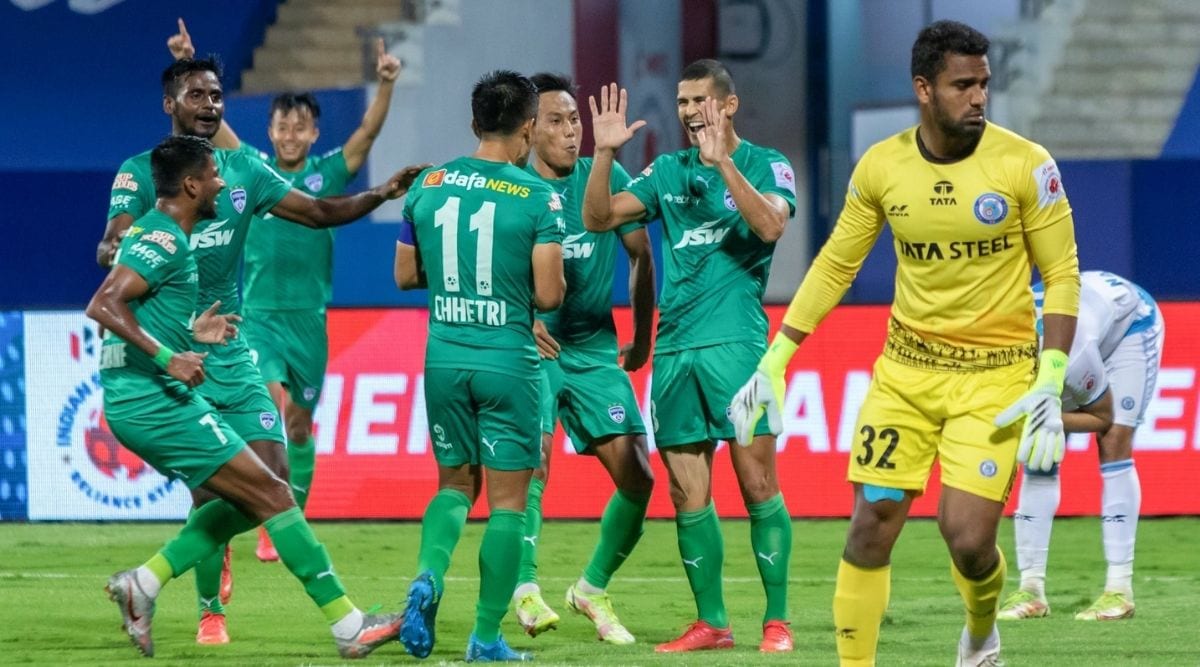 Sunil Chhetri, who became the ISL joint-highest goalscorer on Saturday, reacts after scoring a goal from Parag Shrivas's long throw.
Sunil Chhetri, who became the ISL joint-highest goalscorer on Saturday, reacts after scoring a goal from Parag Shrivas's long throw. It’s remarkable how throw-ins in the Indian Super League (ISL) are an out-and-out attacking option rather than merely being a tool to restart a match.
A case in point is Bengaluru’s equaliser against Jamshedpur on Saturday, which was remarkable for more reasons than one. Firstly, for Parag Shrivas’s long throw: from the touchline on the right, the defender launched a massive throw that sailed almost 20 yards to find the head of his teammate Pratik Chaudhari in a crowded box that had seven Jamshedpur players, including the goalkeeper.
"Will see you there, Bart"@bengalurufc captain @chetrisunil11 has a special message for his fellow joint-top scorer Bart Ogbeche ahead of the Blues' next game against @HydFCOfficial! 😉#BFCJFC #HeroISL #LetsFootball pic.twitter.com/Z4IsDdeB70
— Indian Super League (@IndSuperLeague) February 5, 2022
Equally astonishing was Sunil Chhetri’s run, which almost went unnoticed from Jamshedpur’s point of view. The league’s joint-highest all-time scorer, with 49 goals, wasn’t even in the picture when Shrivas took the throw-in. Chhetri, instead, was positioned outside the box, and while the ball was mid-flight, true to his poaching instincts, sprinted towards the goal area. So by the time Chaudhari got a slight flick on the ball, which then ricocheted off Bruno Ramires, Chhetri was present at the right position to tap it in, thus setting the stage for Bengaluru’s 3-1 comeback win, which propelled them to the third position on the table.
Everything about the move – from the long throw to Chhetri’s sneaky run to the flick and ultimately the finish – gave an impression of the move being a well-rehearsed training ground routine. And that underlines how crucial throw-ins are in the ISL in terms of creating scoring opportunities.
Of course, it’ll be naïve to reduce long throws as just an ISL phenomenon. The ‘strategy’ has been around for long, especially in Indian football, which has produced proper long-throw maestros, who often got selected in the team largely for that one attribute.
Indian ‘tradition’
In the mid-2000s, then Air India coach Bimal Ghosh, who has identified and honed many talented players during his time with the low-budget Mumbai club, signed a defender, Uttam Singh, around whom many of his team’s attacks were designed. Uttam’s hurled projectiles inside the box, which set off panic in the rival defences and led to Ghosh claiming often that he was the first Indian to use throw-ins as a set-piece.
That, of course, is a highly debatable assertion, for there were many players before Uttam who were prolific when it came to powerful throws from the touchline. Former India defender Naushad Moosa, who is now Bengaluru’s assistant coach, made several important contributions with his huge throws; most notably during the final of the 1997 South Asian Football Championship in Kathmandu, when the Maldives could not deal with Moosa’s throws, which led to two goals in a 5-1 win.
Another former India international and Salgaocar star Bruno Coutinho, too, was renowned for his long throws. In Mohun Bagan’s last season in the I-League, defender Dhanachandra Singh made multiple long-throws assists to his name, including one in the biting cold of Srinagar when Bagan beat the 2-0. Dhanachandra, before that, had been influential with his throws in Chennaiyin’s title-winning seasons in the ISL.
And then, of course, there was the intriguing case of Yumnam Singh, who was named by the Guardian in 2020 as one of the 60 next-generation footballers to watch out for. Yumnam, who plays for Punjab FC in the I-League, can hardly be classified as once-in-a-generation talent but if there’s one thing he’s renowned for, it’s long throws.
So while India has had a long, interesting history of producing players who have strong arms and know how to flex them, it’s fascinating to see how what was once a fringe talent has almost become mainstream in the ISL.
Long throws may not be aesthetically pleasing to watch but they surely have been an effective goal-scoring option, almost as important as a corner kick, on which teams spend sufficient time practicing.
‘Not normal’
There have been numerous throw-ins that have led to goals this season. Before Shrivas’s effort, Kerala Blasters’ Sahal Abdul Samad flicked on one of the long throws during his side’s match against Hyderabad, which was volleyed in by Alvaro Vazquez.
At the start of the season, Chennaiyin playmaker Anirudh Thapa threw a ball from the touchline inside the box which was hammered home by Vladimir Koman and in another instance, East Bengal’s Raju Gaikwad – another former Air India man who began under Ghosh and developed a penchant for long throws – hurled one in against Odisha, leading to the first goal in a 10-goal thriller.
Dhanachandra, as mentioned earlier, used the tactic well during his time with Chennaiyin while John Arne Riise, too, terrorised opposition defences with his strong throws during his time in the ISL. So this isn’t a trend exclusive to the ongoing season but still, Hyderabad’s Spanish coach, Manolo Marquez, sounded surprised when asked about it earlier in the season.
“I told my players the other day that I am surprised by two things in the Indian Super League,” Marquez had said.
“One is the number of throw-ins because the throw-in of the players like Raju, (NorthEast United’s) Mashoor (Shereef) and Tondonba (Singh, also from NorthEast United) is not normal, and the other thing is throw-in in India is long. Normally, players would flick it, but they can head the ball directly here.”
It might not be normal. But in the ISL, throw-ins certainly have proven to be more than just a method to restart play.
- The Indian Express website has been rated GREEN for its credibility and trustworthiness by Newsguard, a global service that rates news sources for their journalistic standards.

